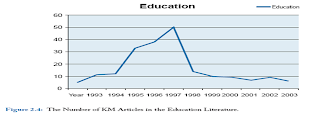
In the early years of KM, it was probably a very safe assumption that almost all KMarticles would have the phrase “knowledge management” in the title, but as the KM field has grown, that almost certainly is no longer a safe assumption. There are now numerous articles about “communities of practice” or “enterprise content management” or “lessons learned” that clearly are KM focused, but they do not use the phrase “knowledge management” in the title.
The significance of the KM growth pattern becomesmuch more apparent when one compares it with the pattern of other major business enthusiasms of recent years. The difference is dramatic. Quality Circles, Business Process Engineering, and Total Quality Management all show an almost identical pattern of approximately five years of dramatic, exponential, growth, then they peak and fall off to near nothing almost as quickly. KM, by contrast, has that same period of five years of exponential growth, 1994 to 1999, but in the decade since it has not declined, rather it has continued to grow steadily and consistently. All the hallmarks are here of a rather permanent development. There has also been substantial interest in the academic world concerning KM.The database ‘Dissertations and Theses’ includes bibliographic information about theses published by graduate students at accredited North American institutions from 1861, and from 50 European universities since 1988. A search of the database showed that all of the dissertations and theses with ‘knowledge management’ in the title or in the key word fields have been published since 1996.


In general, the number of dissertations focusing on some aspect of knowledge management rises gradually until 2006 and has remained steady with about 100 theses produced each year in English with, however, a decline in 2008 and 2009.
An interesting observation is that there was a very brief spurt of articles about KM in journals devoted to education, but that interest soon waned. This is likely a function of the fact that KM, as mentioned previously has a very corporatist and organizational emphasis, while for most academic principals, the faculty, their commitment to their field, their discipline and sub-discipline, their “invisible college” comes first. Their commitment to their nominal home institution is quite secondary. And, for most of those faculty, their invisible college already functions as their community of practice.






0 comments:
Posting Komentar